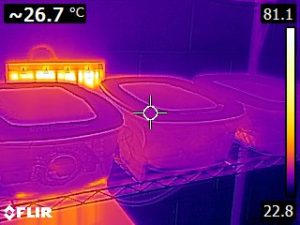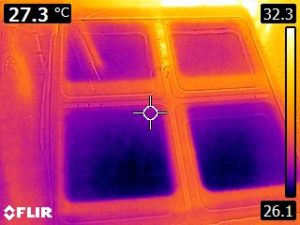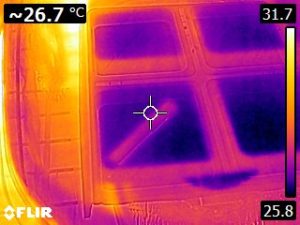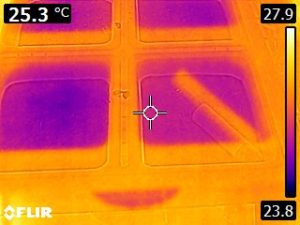All processes, regardless of their purpose, are subject to variability or error. Insect rearing, as a process, is subject to variability, and that variability is often the basis to failures in our systems. We will cover in other blog posts and discussions on this site more of the details of the importance of variability (error) in rearing systems, and we will suggest ways to deal with it to ameliorate some of the error-caused problems. For now, we will use an example of thermal variability in rearing systems.
These images were captured in my rearing room where I am testing some innovations in diets for tobacco hornworms (Manduca sexta). The first figure is a thermal image of 3 rearing cages that contain diets that were poured into 8-cell plastic rearing trays. All 3 cages are on the same shelf, side-by-side. We opened each container and captured the thermal profile of each.
Reading these thermal Images: each image includes a range of colors where (in these images) dark blue is the cooler temperatures, and yellow/white depict the higher temperatures. Also, the scale at the right shows a key to the temperature scale, and in the upper left corner the temperature of the region within the circle is presented. So in the top image, the edge of the center rearing container is circled, and the temperature is 26.7 o C.
First, let us establish that the cylinders in each of the containers are glass tubes used to hold eggs and release neonates to infest the diet. Please note that the temperatures in each container follow a thermal gradient and are characterized by a 4 to 6 degree C range of temperature; and furthermore the diets are always cooler than the plastic sides of the diet tray. In container 1, the diet’s surface temperature (where the insects are feeding) ranges from about 26 C to about 28 C. This is quite different (in terms of temperature) from container 3 where diet in the lower right hand cell is about 25.3 degrees C. Therefore, despite the fact that the insects are being held in the same types of containers on THE SAME SHELF in the rearing room, there is chronic (continuous) exposure to temperatures that are at least 1-2 degrees C different from one-another. Knowing how important temperature is as a growth/metabolic determinant, it is clear that we have inadvertently imposed a temperature factor in the rates of growth–a factor that is going to cause an error that detracts from our interpretation of the diet evaluation!
Take home message: nearly every factor/component in our rearing systems has an inherent variability (error). If we recognize these factors/sources of error and try to correct them, we will improve our rearing process (i.e. we will CONTROL it).




